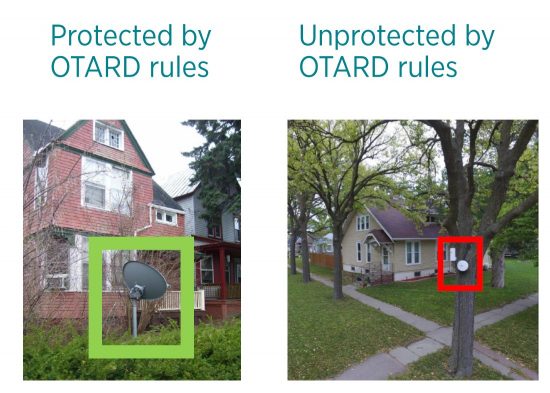On January 7, with the Pai FCC winding down, the agency made an important rule change that gives US households more broadband options. Small, outdoor broadband antennas installed on private property will be shielded from “unreasonable” state and local restrictions and fees, much like satellite TV dishes are protected today. The practical effect is most consumers can install small broadband devices on their rooftops, on their balconies, or on short poles in their yards in order to bring broadband to their home and their neighbors’. The FCC decision was bipartisan and unanimous and will open up tens of millions of new installation sites for certain 5G small cells, WISP systems, outdoor WiFi, mesh network nodes, and other wireless devices.
Previously, satellite dish installation was protected from most fees and restrictions but most small broadband antennas were not.

The rule change involved the FCC’s 20 year-old over-the-air-reception-device (OTARD) rules, which protect consumers from unreasonable local fees and restrictions when installing satellite TV dishes. The rules came about because in the 1990s states and cities often restricted or imposed fees on homeowners installing satellite TV dishes. Congress got involved and, circa 1998, the FCC created the OTARD rules, aka the “pizza box rules,” to protect the installation of TV dishes less than 1 meter diameter.
In recent years, homeowners and tenants increasingly want to install small, outdoor broadband antennas on their property to bring new services and competition to their neighborhood. However, they face many of the same problems satellite dish installers faced in the 1990s. From my comments (pdf) to the FCC in the proceeding:
For instance, a few years ago a woman in the Charlottesville, Virginia, area switched from cable to less expensive satellite TV service in order to save money after being laid off. She had a satellite dish installed in her front yard—the only place the dish could receive an adequate signal. A city zoning official sent her and about 30 neighbors letters informing them that their (OTARD rules-covered) satellite dishes were, per local ordinance, unpermitted accessory structures. Any homeowners who did not remove their dish faced fines of $250 per day.
Fortunately for the homeowners, the woman was familiar with the OTARD rules and informed the local officials of the FCC’s authority.38 After being informed of the FCC’s OTARD regulations, the city officials declined to enforce the local ordinance and agreed to revisit the ordinance for compliance with FCC rules.
Today, WISPs and other broadband providers face similar issues when trying to install antennas on private property. It’s hard to know how much the OTARD rules helped expand satellite TV penetration but it helped. The FCC rules coincided with the installation of 20-30 million small dishes on private property.
With the rules extended to broadband antennas, operators will have millions more low-cost siting options. One provider, Starry, wrote to the FCC that today “it takes on average 100 days to complete the permitting process for a single base station, which accounts for about 80% of the time that it spends in activating a site.” Starry says that with the January 2021 rule change, they’ll likely activate 25-30% more antenna sites in the next year, bringing a broadband option to 1 million additional households. Take projections with a grain of salt, but it’s clear the new rules will improve coverage and competition.
There are some exceptions. States and cities are able to restrict antenna installation if they can show a safety hazard or a historic preservation issue. Generally, however, the rules are protective of homeowners and tenants. The changes faced some opposition from cities, counties, and homeowners associations but it’s great to see a bipartisan and unanimous decision in the final days of Chairman Pai’s broadband expansion-focused tenure to give consumers more protection for installing and self-provisioning small broadband antennas.

 The Technology Liberation Front is the tech policy blog dedicated to keeping politicians' hands off the 'net and everything else related to technology.
The Technology Liberation Front is the tech policy blog dedicated to keeping politicians' hands off the 'net and everything else related to technology.